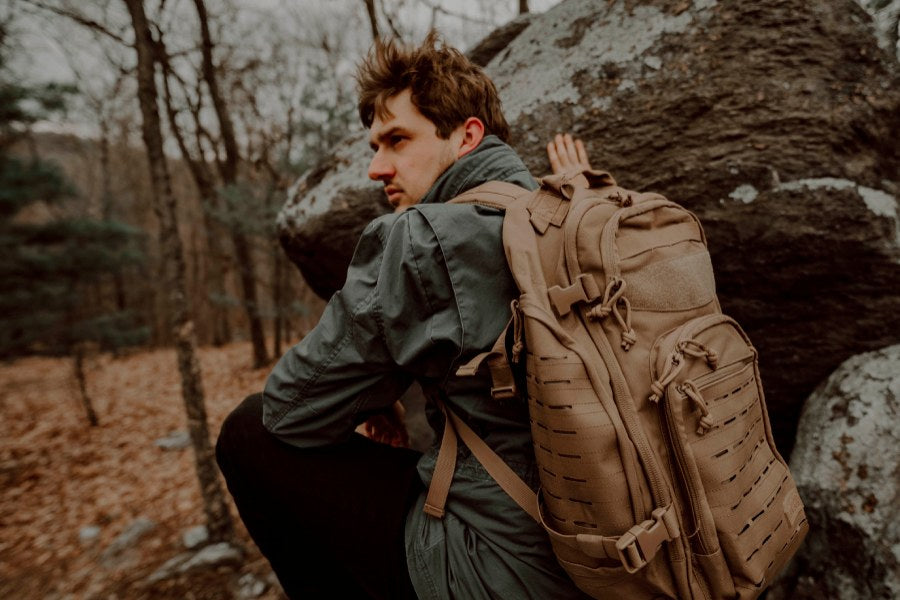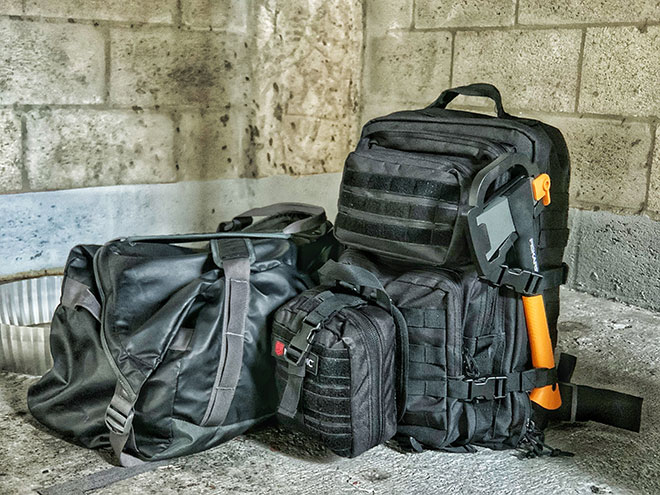Bug Out Bag is a carefully chosen collection of essentials for emergencies to help you stay safe and self-sufficient when unexpected events happen. Imagine a situation where natural disasters or civil unrest occur. Your bug out bag is crucial, holding supplies like food, water, first aid, tools, and communication gear to help you survive independently. Having a bug out bag isn’t just about surviving; it’s about being resilient and adaptable. It gives you the tools to prepare for worst-case scenarios, offering comfort during crises.

Bug-Out-Bag
TABLE OF CONTENT
- History of Bug Out Bag
- Trends in Bug Out Bag
- Materials in Bug Out Bag
- Building Your Bug Out Bag

Bug-Out- Bag
History of Bug Out Bag
Military Origins:
The idea of being ready in the military led to the first bug-out-bags. Soldiers required quick-access packs with necessary items like medical supplies, food, and tools, especially during World War II and the Cold War.
Civilian Adaptation:
As military tactics changed, regular people started doing similar things. Natural disasters and unrest made individuals create their bug-out-bags with things they needed to survive. This change included items like tools for water purification, devices for communication, and personal hygiene products.
Pop Culture Influence:
Movies, TV shows, and books made bug-out-bags famous, showing them as very important in made-up disaster situations. This influence raised public awareness and interest, making preppers and everyday people use them more.
Modern Applications:
Nowadays, bug-out-bags are crucial for being ready for emergencies in many situations. They’re not just for survival fans but are also suggested by groups managing emergencies and helping in disasters worldwide. The focus now is on being sustainable, compact, and useful, with new materials and technology making these kits better.
Trends in Bug-Out-Bag
Rising Popularity Across Different Groups:
Bug-out bags are not just for survival experts or “preppers” anymore. More and more people from various backgrounds are realizing the importance of being prepared for emergencies. Families, city residents, and even professionals are putting together bug-out bags to make sure they are ready for unexpected situations like natural disasters or blackouts.
Personalized and Tailored:
There is a growing trend of customizing bug-out bags to suit individual needs and lifestyles. Instead of generic kits, people are personalizing their bags by including items that are specific to their own requirements. This could mean adding medications, baby supplies, pet essentials, or specialized tools. The aim is to create a bag that is as practical and useful as possible for each person’s unique circumstances.
Environmentally Friendly Choices:
With a growing awareness of the environment, more individuals are choosing sustainable and eco-friendly items for their bug-out bags. Reusable water bottles, solar-powered chargers, biodegradable hygiene products, and bags made from sustainably sourced materials are becoming popular options. This trend reflects a broader commitment to environmental responsibility, even in emergency readiness.
Integration of Technology:
Modern bug-out bags are increasingly using technology to improve survival and communication. Portable solar panels, small power banks, and hand-crank radios with USB ports are now common features. These technological tools help ensure that individuals can stay connected and informed during emergencies, providing a crucial connection when traditional power sources and communication channels are not available.
Materials in Bug Out Bag
The Backpack
Choose a strong, water-resistant backpack that is comfortable to carry for long periods. Look for padded straps and multiple compartments to keep your things organized. Pick a durable material like heavy-duty nylon or polyester that can handle rough conditions.
Food and Water
Pack foods that won’t spoil such as energy bars, dried fruits, and canned goods. Bring a lightweight stove or a way to heat food. Carry bottled water and a portable filter or purification tablets to ensure you have safe water if you run out.
First Aid and Health
Pack a basic first aid kit with bandages, antiseptics, pain relievers, and any personal meds. Include a multi-tool, emergency blanket, and hygiene items like toothbrush, toothpaste, and soap. Remember face masks and hand sanitizers, especially important nowadays.
Tools and Shelter
Bring a multi-tool with a knife, pliers, and screwdriver. Have a flashlight with extra batteries, waterproof matches, and a fire starter for light and warmth. Pack a light tent or tarp with rope for shelter, and a sleeping bag or thermal blanket for warmth. A map and compass or GPS can help you find your way if electronic devices don’t work.
Building Your Bug-Out-Bag
Right Bag
Start with a strong, comfortable backpack. It should be large enough to carry your essentials but not too heavy. Look for one with multiple sections to help you organize your things.
Essential Supplies
Bring bottled water and non-perishable food like energy bars or canned goods. A portable water filter can also be important. Pack extra clothes, tough shoes, and a small sleeping bag or emergency blanket. A light tent or tarp can give you shelter. Carry a basic first aid kit with bandages, wipes, and pain relievers. Remember personal hygiene items like a toothbrush, toothpaste, and hygiene products. Include a multi-tool, flashlight, batteries, waterproof matches, and a whistle. A portable phone charger and a small radio can help you stay informed and connected.
Personal Needs
Think about any special needs you or your family members have. This could be medications, glasses, or baby supplies. If you have pets, bring along food and essentials for them too.
Maintenance
Regularly check and update your emergency bag. Swap out expired food and water, adjust clothing sizes if necessary, and ensure batteries are charged. Aim to review your bag every six months to make sure everything is in good condition and ready for use.
FAQ
What is a bug-out bag, and why do I need one?
Answer: A bug-out bag is a portable kit containing essential items needed for survival during an emergency . It typically includes supplies like food, water, clothing, tools, and first aid. The purpose of a bug-out bag is to ensure you can sustain yourself for at least 72 hours when you’re away from home or during a crisis.
What should I include in my bug-out bag?
Answer: Essential items for a bug-out bag include water (at least 1 gallon per person per day), non-perishable food, a first aid kit, clothing, a flashlight, batteries, a multi-tool, a fire starter, a map, important documents, and hygiene products.
How often should I check and update my bug-out bag?
Answer: It’s advisable to check and update your bug-out bag every six months. Regularly inspect items for expiration dates, especially food, water, batteries, and medications. Update the contents to reflect any changes in your personal situation, such. as new health conditions, additional family members, or seasonal changes.
Where should I store my bug-out bag?
Answer: Store your bug-out bag in an easily accessible location, preferably near an exit. Common places include a closet near the front door, the trunk of your car, or under your bed. The goal is to have it readily available so you can grab it quickly in an emergency.
How much should a fully loaded bug-out bag weigh?
Answer: Ideally, a fully loaded bug-out bag should weigh no more than 20-25% of your body weight. For most people, this translates to around 15-25 pounds. Keeping the bag lightweight ensures that you can carry it comfortably over long distances without causing excessive strain. Focus on including only essential items and avoid overpacking to maintain a manageable weight.
CONCLUSION
A bug-out bag is not just a bunch of emergency stuff; it’s like a safety net during emergencies, giving you a sense of security and calm when things go wrong. Knowing what to put in it, how often to refresh it, and where to keep it helps you be ready for unexpected situations. The materials used in making a strong and comfy bug-out bag, like tough fabrics, water-resistant coatings, extra-strong stitching, and user-friendly features, make sure your gear can handle tough conditions and is easy to carry. Regularly checking and updating your bug-out bag is important to make sure all items are working and still useful, adjusting to changes in your situation and surroundings. Remember to keep the weight manageable by focusing on essentials so the bag is easy to carry for long distances. This way, your bug-out bag stays a reliable asset, ready to help you when needed.
Having a well-prepared bug-out bag reflects the idea of “Be prepared.” It’s about being independent, thinking ahead, and being able to deal with emergencies confidently and strongly. As you put together and look after your bug-out bag, you’re not just gathering supplies—you’re investing in your safety and health, making sure you’re prepared to safeguard yourself and your family when it’s most important.
Source by-: https://images.app.goo.gl/cMnMpet2tMd5EGU19
https://images.app.goo.gl/6nnXwoRvDF7WJGYd6
Written by :- https://bioleather.in/bug-out-bag-survive-in-style/
Comments on “Bug Out Bag : Survive in Style”